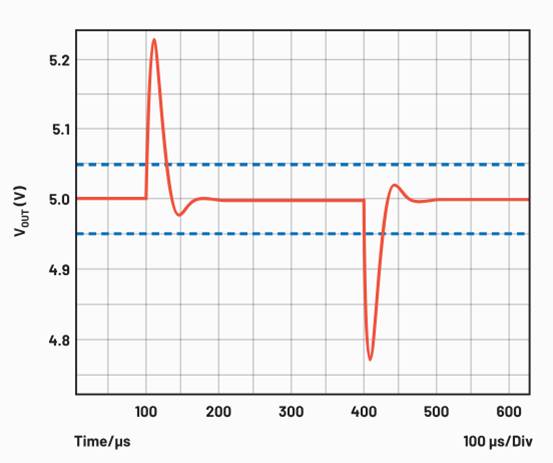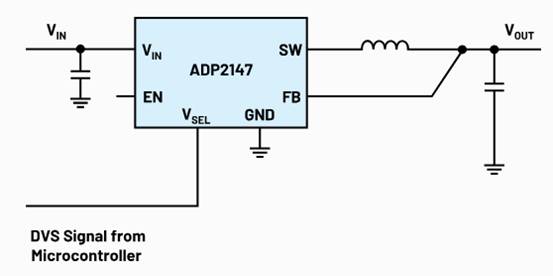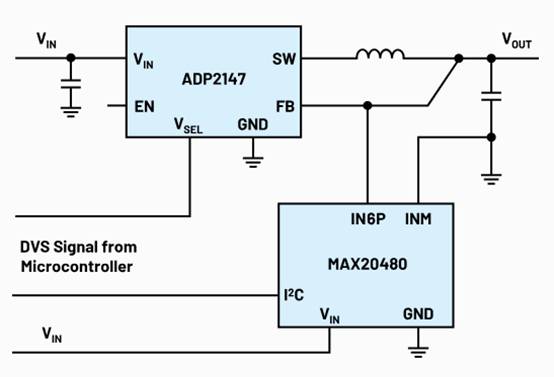When strict regulation of the power supply voltage is required, the direct current (DC) voltage accuracy specifications in the datasheet of a switching regulator can be utilized. This accuracy value is typically ±1% or ±0.5%. If an external resistor divider is used in the feedback path of the voltage converter, the tolerance of the resistors must be considered when calculating the voltage accuracy.
In addition to DC accuracy, dynamic voltage accuracy must also be taken into account. In the event of a load transient, where the load suddenly consumes high current, the generated voltage may go below or above the setpoint voltage and then stabilize at the setpoint level. This behavior depends on the speed of the control loop. For applications that require strict regulation of the power supply voltage, precise voltage is usually required during such load transients. Figure 1 illustrates the typical voltage response in the time domain after a load transient. It can be observed that a load is connected 100μs later, and the load is disconnected 400μs later.

Advantages of DVS Technology
DVS has several advantages that contribute to achieving higher precision in voltage regulation. With DVS technology, it is possible to adjust the output voltage near the setpoint to compensate for load transients and provide stricter regulation. As shown in Figure 1, the voltage fluctuations after a load transient are typically much higher than the DC accuracy limit of the power supply voltage. The dashed line in Figure 1 represents the 1% accuracy limit.
To control these sometimes very high voltage fluctuations within the specified accuracy range, the use of DVS makes sense. For instance, when the load is low, assuming a load transient to a high load will occur next, the output voltage will be slightly increased before the load transient occurs (e.g., increased to 5.2 V). However, the magnitude of the voltage drop will not change as a result. The voltage does not drop from 5 V to 4.75 V; instead, it drops from 5.2 V to 4.95 V. When there is a high load current, the voltage will slightly decrease because it is generally expected that the load will drop again at some point. This prevents the voltage overshoot from being too high.
The buck switching regulator circuit shown in Figure 2 is a simple implementation of DVS. For example, by applying a microcontroller signal to the VSEL pin, indicating whether the generated voltage should be slightly increased. When using a simple DVS implementation, the system must generate this command and provide it to the switching regulator. Some switching regulators implement more complex DVS systems. When using these systems, various load threshold values for DVS switching can be directly programmed.

In some cases, applications that require strict regulation of the voltage may need to monitor the IC to check whether the generated voltage is indeed within the tolerance range. When there is no load transient, a simple power monitor chip is sufficient to check the DC voltage, which is typically within a narrow range. However, this does not apply to DVS systems because their DC voltage has two different values: sometimes higher and sometimes lower.
Special monitoring ICs (such as the MAX20480 power system monitor) can also be used in conjunction with DVS systems to achieve reliable voltage monitoring. The MAX20480 features a digital I2C interface; like the switching regulator in Figure 2, it can dynamically switch through the VSEL pin and can be used to monitor higher or lower DC voltage when using DVS systems. Figure 3 shows the block diagram of the DVS switching regulator in Figure 2, with the addition of a voltage monitoring IC that supports DVS.

Conclusion
Using some interesting solutions can generate a precision power supply voltage with high DC accuracy and dynamic accuracy. DVS is particularly useful, and many specialized ICs supporting DVS (including the MAX20480 power monitor IC) can be used for monitoring the generated voltage. Such ICs can enhance performance while reducing costs associated with power conversion systems.